

 How did so many Irish immigrants end up in the United States and in Wheeling?
How did so many Irish immigrants end up in the United States and in Wheeling?
There were many waves of immigration. But the biggest one related to the Gaelic -mostly Catholic- Irish, was caused by starvation.
In oversimplified terms: by the mid-19th century, the tenant farmers and working poor of Ireland had become dependent on the potato crop for survival. Starting in 1845, an insidious potato blight resulted in crop failure after crop failure. People starved.
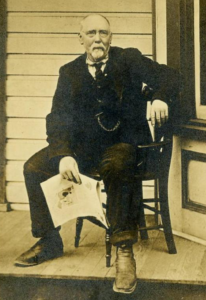 All of Ireland was still under British rule at the time, but the British government adopted a hands-off policy, citing the “Free market.” During the ensuing “Great Hunger,” more than one million people died of disease or starved to death even as food grown in Ireland was exported. Unable to pay rent, tenant farmers and their families were evicted from their homes. More than two million people left Ireland, most crossing the Atlantic on “coffin ships.”
All of Ireland was still under British rule at the time, but the British government adopted a hands-off policy, citing the “Free market.” During the ensuing “Great Hunger,” more than one million people died of disease or starved to death even as food grown in Ireland was exported. Unable to pay rent, tenant farmers and their families were evicted from their homes. More than two million people left Ireland, most crossing the Atlantic on “coffin ships.”
Thousands of these “Famine Irish” ended up in West Virginia and Wheeling. Many found work on the B.& O Railroad. My own great-great grandfather, John Charles Duffy was a conductor of the B. & O. from Grafton to Wheeling.
The immigration graph below made by the Wheeling Chamber of Commerce in the 1930s shows the Irish population just under that of the German influx in the late 19th century.
B & O Conductor John Charles Duffy. (R)
But as was the case elsewhere, Gaelic Irish were not always welcome in Wheeling. This infamous "No Irish Need Apply" sign is reflected in a Wheeling job want ad from 1854.
This early negative reaction to the Irish foreshadows the reaction to future waves of immigrants, including by the Irish themselves, post assimilation.
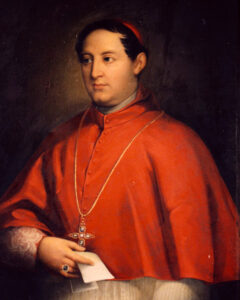 The Papal Nuncio, Cardinal Gaetano Bendini.(R)
The Papal Nuncio, Cardinal Gaetano Bendini.(R)
Vividly illustrating this theme is a dramatic anecdote, also from 1854. An ambassador of Pope Pius IX, Nuncio Gaetano Bendini, visited Wheeling at the invitation of Bishop Richard Whelan, head of the relatively new Diocese of Wheeling. According to several accounts, a mob of anti-Catholic “Know-Nothings” took to the streets, burned an effigy of the ambassador, delivered anti-Catholic speeches and later approached St. James Cathedral carrying rocks and clubs. Anticipating trouble, Bishop Whelan had assembled an armed guard of approximately 100 local Irish men. Confronted by Whelan’s armed Irish (and German Catholic) guard, the frustrated mob made threats and threw stones, but more serious violence was averted. Unharmed, the ambassador was spirited out of Wheeling the next day by train.
Text of the handbills posted around town by the nativists:
"Freeman, Arise! Bedini, the Butcher of Italian Patriots, the Tyrant of Italy is in our city! Aye, the guest of the Catholic Bishop. He is on a mission through our Union as a kind of Papal Ambassador and should nowhere be tolerated by American Freeman, as he is not worthy to breathe the free air of this Country, yet he is feted everywhere by the Jesuits, to the great annoyance of free American citizens. Americans! Citizens of the greatest and most liberal Republic on earth, do not disgrace your reputation by tolerating such a monster as Bedini in your midst. Do not shelter one who has murdered the patriots of Italy! Give us your cooperation and help us to destroy the secret plans of the Roman missionary. The blood of the martyrs of freedom, the tears of widows and orphans, the poor down-trodden people of Italy call for revenge! Let them have it. Drive this monster back to his bloody master that sends him! Come one, come all and let the cry of the city be heard - Down with Bedini."-James Connelly, The Visit of Archbishop Gaetano Bedini to the United States of America (June 1853-February 1854)
[Note: Trouble followed Bendini's tour. Prior to his Wheeling visit in Dec. 1853, Cincinnati Know-Nothings allied with German-American "Forty Eighters" to cause a riot over his visit there.]
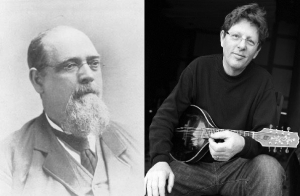 Among the Irish Guard was Thomas O'Brien, Great grandfather of Wheeling musicians Tim and Molly O'Brien.
Among the Irish Guard was Thomas O'Brien, Great grandfather of Wheeling musicians Tim and Molly O'Brien.
This incident has been written about several times, including most recently by Nora Edinger in the Wheeling Intelligencer. But context is added through letters (housed in the Diocesan archives), penned by Visitation Sisters who were eyewitnesses to the events. The text below, for example, is transcribed from a letter sent by a Sr. Mikey (Visitandine) to the sisters at the Baltimore Visitation Monastery and is dated January 11, 1854 (emphasis added):
We had the honor of seeing the Pope’s Nuncio & Secretary visit us & our Academy where an address & music awaited his entrance. He gave the Y. Ladies a holiday; he was most Paternal & all at ease with us. He is beginning to speak quite well in English. Twice he visited St. Joseph’s school where he appeared in delight & ecstasy so much is his heart like to that of our dear Lord. He could not make himself little enough to put everyone at her ease with him. He distributed more than 190 children pictures, medals & crosses & an abundance of goodies – their annual feast of the Epiphany is always provided for them by our holy Bp. – on the boys’ side the same. On the Epiphany the Pope’s Nuncio officiated pontifically & gave the papal Benediction. He has a fine voice, was most grateful & Saintly at the ceremonies. He remarked that nowhere in this country had he seen all the ceremonies so well performed as in our sanctuary and we with Pride, had remarked that he himself did nothing more than we had been accustomed to see our Bishop perform in celebrating. The singing was very fine, our Bishop excelled himself in his sermon, making it altogether appropriate to the day & to our holy visitor. As soon as the news of the Pope’s Nuncio arrival was circulated, an excited group was stirred up. Placards with shameful things on them were put up & throughout the city were noises & tumult & crowds. They burned him in effigy, gathered about the Cathedral, broke the painted glass windows but feared to turn the corner to the Bp’s house where more than 100 men were armed & many more prepared to repel any attack. Our Sisters suffered much by fear, but I felt safe knowing how many were on watch with 25 armed men patrolling the street at a time. We were watchful & avoided having lights about & going to the window. The Catholic gentlemen carried about with them arms. For two days and nights we were in defense & in a state of consternation. The Holy Nuncio evaded their attacks by going from place to place; he was much alarmed & wd. willingly have left our city to save it, the confusion his arrival occasioned. But our Bp would not consent to it, for he was daring & wd. not let the people put him down by their threats & all they wanted was to burn down the Cathedral & Convent. But “if our Lord is for us, who can be against us?” Unfortunately on that same night there was a “supper” for the benefit of the Steeple by the Catholics (Saturday night). They expected the Pope’s Nuncio wd. be there. They collected around the house & burned the Nuncio in effigy & in ridicule collected to put it out & so great was the noise & insult the Ladies had to come away & to leave the tables so great was the danger & confusion. The gentlemen were all armed – a great deal more than I can write. But the consequence – little made at the Supper where so much was expected. Thank God all is quiet now. Stones were thrown up at our house & fire crackers aplenty. The second night our Sisters did not undress, not knowing what wd. happen; I did. We had no man or servant, but I know our Bp. & clergy were all anxiety & watchfulness of us. We are all well & safe.
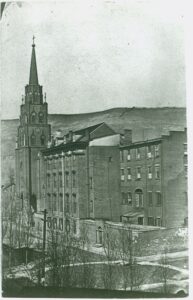 St. James Cathedral (left) was built in 1847 and replaced by the current St. Joseph's in 1924. Archives of the Diocese of Wheeling-Charleston.
St. James Cathedral (left) was built in 1847 and replaced by the current St. Joseph's in 1924. Archives of the Diocese of Wheeling-Charleston.
Sr. Mikey confirms that the mob burned the Nuncio in effigy and broke windows at the Cathedral with stones while 100 armed men in patrols of 25 prevented further violence. This journal entry from an unidentified nun offers further clarification:
The following incident will show you how rabid & bitter the people were we had to deal with. Cardinal Bedini, the Pope’s Nuncio, came to this country, visited Wheeling on his way to Cincinnati. Immediately the city was in an uproar, malicious lies were printed & thrown in the doors & gardens of the houses to excite the hatred & frighten the Catholics. A charity fair was going on in Washington Hall. The Nuncio was supposed to be there. A crowd soon was looking for him. Not finding him there they began to insult the people present. Many persons were alarmed & ran home fearing for their lives. The Pope’s effigy was burned by the boys who hallowed “down with the pope,” “hang him up,” etc. Then the mob turned towards our venerable Bishop’s residence & threatened to burn the house & church if the Nuncio was not given up. Our fearless Bishop appealed to the mayor for protection but it was not given him. In the meantime a body of faithful Catholics, Irish & German, had entered the Cathedral basement in the back way to defend the church. Their beloved pastor & the Nuncio, our valiant bishop walked up & down in their midst to keep them quiet. He said “don’t mind the mob throwing a few stones but if they attempt to enter then you may attack them.” Our fears are not easily imagined thus described. Our convent was next to the Cathedral & we could clearly hear their wild speeches. Many said “perhaps the Nuncio is in the convent. Down with the nuns & priests!” The old sisters say that no one slept that night as frightened Mother Michaella ordered all lights to be put out. Oh! how we prayed that night. In the meantime our good Bp. got the Nuncio out of the city in disguise. The mob was assured that he was not with the Bishop ____ away to our great relief. Rev. Fr. Brazill & Mr. Ben Watson, an ardent & devoted convert, got a carriage & pretended to drive the Nuncio to the dept. “We will disguise ourselves & talk Latin to each other when the crowd is around. The ignorant mob will think that is Italian we are speaking & think one of us is the Nuncio. In the meantime the Nuncio can be safely sent away to Cincinnati.” Cardinal Bedini was very much alarmed at the fury he created in many American cities.
Here we learn that some of the action, involving "the boys," took place at Washington Hall, where the effigy of the Pope himself was burned and the Cathedral's armed guards were both Irish and German. The nuns and priests were also threatened. The Nuncio's escorts spoke Latin to confuse the nativist mob. Finally, here’s what John G. Shea had to say about the Nuncio's visit in his History of the Catholic Church in the United States:
When Archbishop Bedini visited Wheeling, the infidels from the continent of Europe prepared to mob the envoy of the Pope and attack the Cathedral. The mayor of the city deployed his inability to afford protection. Bishop Whelan told the chief magistrate of the city that he would take the protection into his own hands, and asked him to make known to the rioters that the first one who passed within the Cathedral railings would be unhesitatingly shot down. The Bishop prepared accordingly, and when the rioters came cursing and howling, they abstained from actual violence. One of them did throw a stone and break a pane of glass, but as he was promptly felled to the ground by a strong arm, the mob, finding that there was serious work before them, disbanded.
Insofar as this rather dramatic incident accurately reflects the prevailing national relationship between Irish Catholic immigrants and their tormentors, it serves to explain as well as anything, the rise of Hibernianism in Wheeling and in the entirety of what would become the state of West Virginia, and indeed, the United States. [Note: "Hibernia" is a Roman/Latin word for Ireland]. First organized in New York City in 1836, the Ancient Order of Hibernians in America provided Irish Catholics with a structure – inspired by centuries old secret defensive societies in the homeland – through which to band together to protect their faith and their comrades. The unity demonstrated by Whelan’s armed Irish guard epitomized the core mission of the order – they defended their church and clergy against a potentially violent mob, and without bloodshed. This is how fraternal Societies like the Ancient Order of Hibernians were formed, as defenders of the Catholic Faith from nativist attacks.
This illustration by an unknown artist shows how it might have looked when armed men guarded a church from a nativist attack. 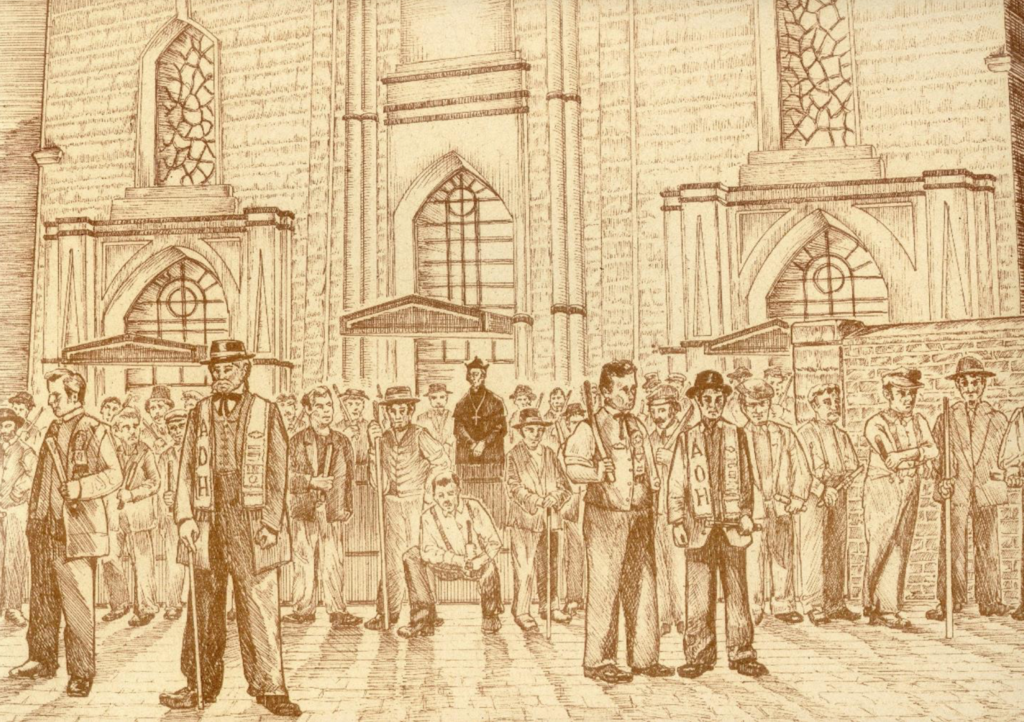
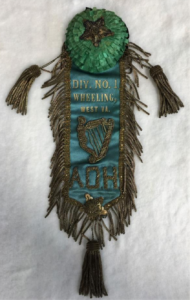 Original Parke Division No. 1 badge, circa, 1915. Duffy collection.(left)
Original Parke Division No. 1 badge, circa, 1915. Duffy collection.(left)
Wheeling had two divisions of AOH by 1874 (Parke and Mullen) and there was a division in Benwood associated with St. John’s Catholic Church. When the Church was being built, members stood guard so that the Ku Klux Klan could not sabotage the construction. A second Marshall County Division formed around St. James Church in McMechen, Benwood’s neighbor to the south. The new Harris Division of the A.O.H. was named in honor of the parish’s second pastor, Rev. Father Richard F. Harris, an immigrant from County Cork. The local A.O.H. presence in Ohio included, at least, Toronto, Steubenville, Martins Ferry, Bridgeport, and Bellaire divisions. The Ancient Order of Hibernians was resurrected in Wheeling a century and a half after Bishop Whelan organized the Wheeling Irish. The new incarnation, Wheeling Division Number 1, marches annually in the Pittsburgh St. Patrick's Day parade and organizes the world's largest annual Irish road bowling event, which regularly attracts nearly 1000 bowlers or wildy variable skill levels.
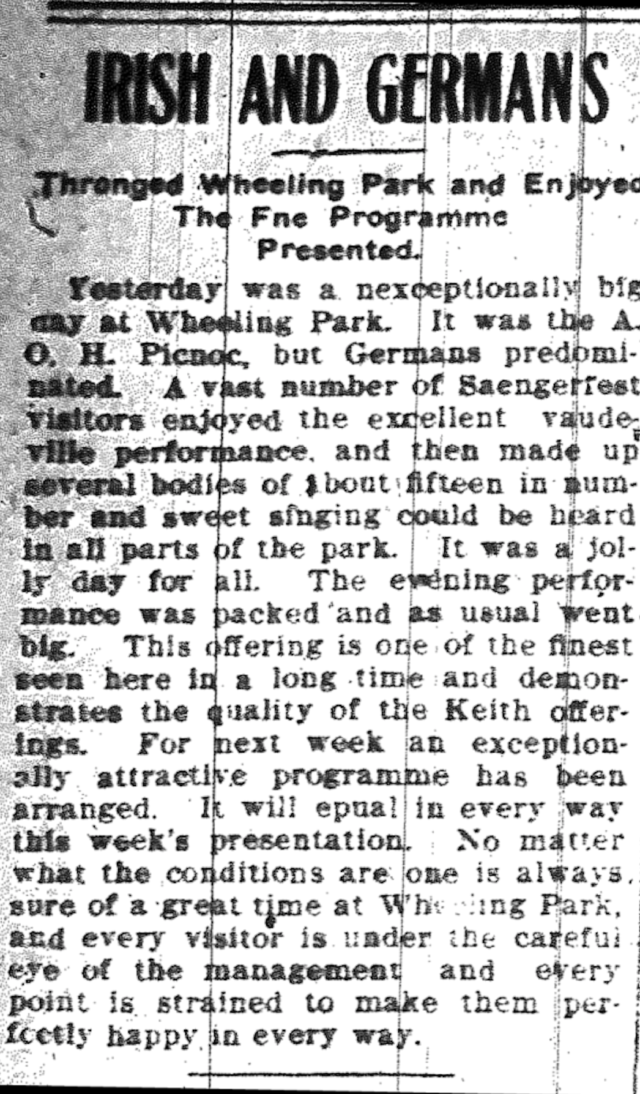 By the late 19th century, the four northern panhandle A.O.H. divisions began hosting large summer picnics, “Irish Days,” usually celebrated at Wheeling Park or Mozart Park, which were both, at the time, essentially beer gardens operated by Wheeling’s two largest German brewery owners: arch rivals Anton Reymann (Wheeling Park) and Henry Schmulbach (Mozart).
By the late 19th century, the four northern panhandle A.O.H. divisions began hosting large summer picnics, “Irish Days,” usually celebrated at Wheeling Park or Mozart Park, which were both, at the time, essentially beer gardens operated by Wheeling’s two largest German brewery owners: arch rivals Anton Reymann (Wheeling Park) and Henry Schmulbach (Mozart).
Typical Irish Days featured activities like balloon ascensions, tug-o-war, quoit pitching, horseshoes, bowling, running races, putting the stone, and throwing the hammer, “fat man” and “fat woman” races, potato races, bicycle races, and sack races. Prizes included things like “a gold watch chain and a fine shirt.” Cake walks (dances) were sometimes held at the Wheeling Park Casino. Irish music was provided by orchestras, brass bands (cornet bands) and pipers, and was often accompanied by dancing of jigs and reels.
Interestingly, the 1906 picnic was held during the same weekend as Wheeling’s last Saengerfest, a large gathering of regional German Singing Societies including Wheeling’s own Mozart, Arion, and Beethoven, among others. Wheeling Park was a popular hang out for the visiting Germans. “Irish and Germans,” The Daily Intelligencer’s subhead proclaimed, “Thronged Wheeling Park and Enjoyed the Programme Presented. Yesterday was an exceptionally big day at Wheeling Park…It was a jolly day for all.” A jolly day indeed – especially for Mr. Reymann, who undoubtedly enjoyed a record sales day for his popular brew.
In addition to the annual picnics, the local A.O.H. divisions often offered banquets, recitations, music, dancing, card playing, and even Irish-themed plays, featuring performances by A.O.H. and Ladies Auxiliary A.O.H. members in honor of St. Patrick’s feast day. Euchre was highly popular at such gatherings, as were other parlor games such as bridge, 500 and bunko.
The biggest concentration of Irish in 19th century Wheeling was in the working class section of South Wheeling, in an area known as “Irish Row," a ramshackle brick tenement located in the Eight Ward between 36th and 37th Street east of Wood Street to the alley known now as Lane G. It was erected originally in the mid-19th century as part of the employee housing for the Hobbs-Brockunier glass factory -"when the Hobbs Glass factory was in the embryo...It was erected to accommodate glass workers, mostly humans of Hibernian extraction...""[Register: 11-15-1927 and 01-21-1902].
I've identified the location using newspaper references. 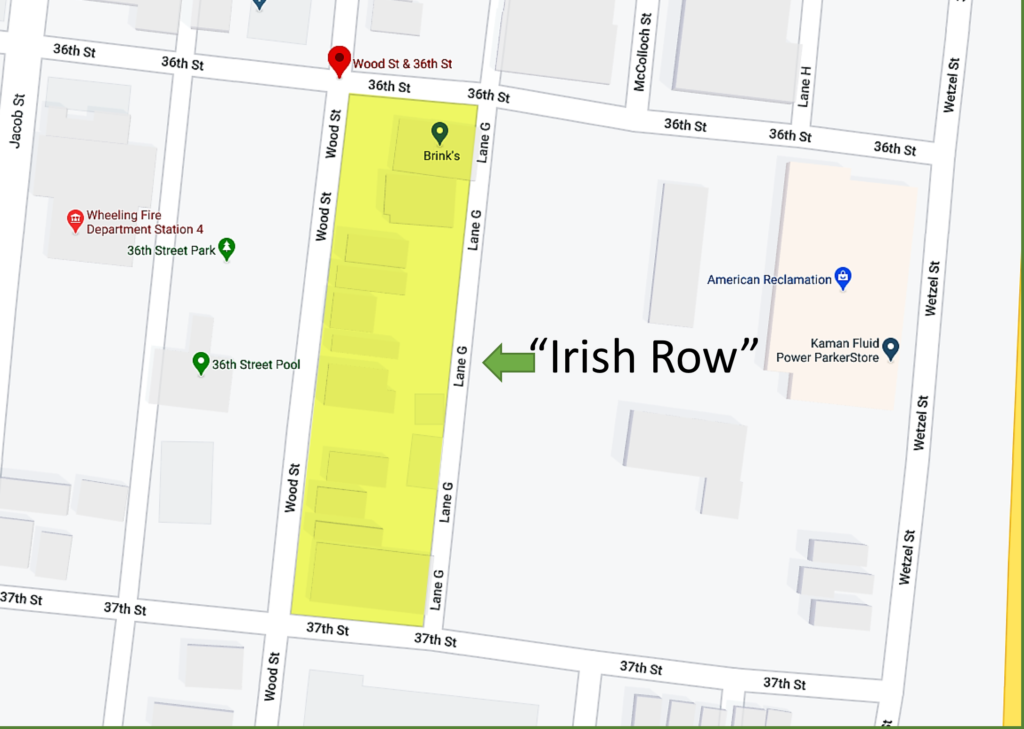 Here’s what that area looks like today.
Here’s what that area looks like today. 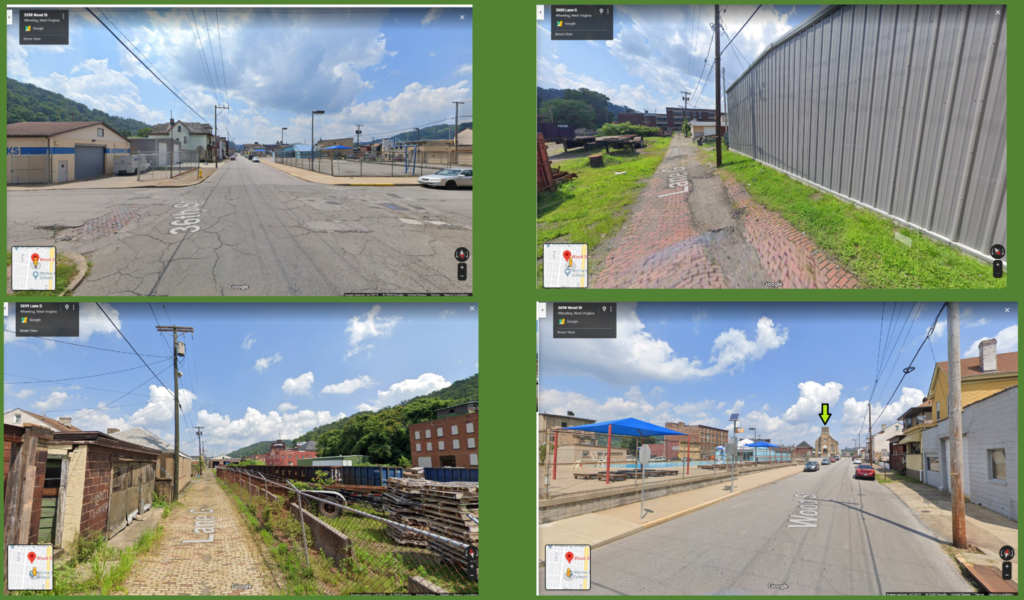 Looking north (bottom right) one can see a church in the background (arrow). That was the Immaculate Conception, commonly known as “St. Mary’s” or the “Irish Church.”
Looking north (bottom right) one can see a church in the background (arrow). That was the Immaculate Conception, commonly known as “St. Mary’s” or the “Irish Church.”
It was dedicated on September 14, 1873. In 1875, a second Wheeling division of the Ancient Order of Hibernians was organized by members of St. Mary’s Parish. First known as Emmet Division No. 2 in honor of the Irish nationalist and rebel leader, Robert Emmet, the name was changed to Mullen Division No. 2 in 1906 in honor of Rev. Joseph Mullen, the second pastor of St. Mary’s, who was born in County Louth, Ireland. 
This is what the church looked like in the early 20th century (below). It still stands, its bricks covered in a flagstone façade, and now serves as a Baptist Church (left).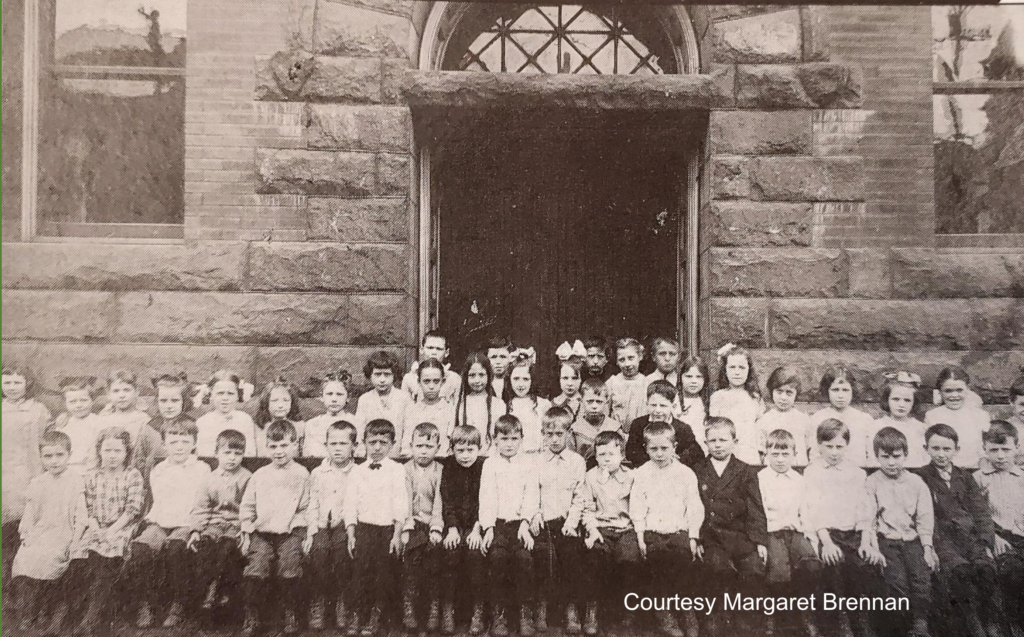
 Intelligencer: Jan. 21, 1902, page 6 (left)
Intelligencer: Jan. 21, 1902, page 6 (left)
Though originally a "congenial neighborhood," comprised of "respectable and peace-loving" residents from the "Ould Sod," the Row "descended" into "gory fistic encounters" after "many a keg of amber fluid was emptied..." [Register: 01-21-1902].
Irish Row apparently degenerated into a place of poverty, alcoholism, violence, and crime. Contemporary descriptions will remind one of the Five Points Mission in the film Gangs of New York.
Still, the denizens of Irish Row were civilized enough to field a "base ball" team. Known as the Irish Row Sports, they were defeated in a "game of ball" on the "Brick Yard grounds" 3-0 by the Pick Ups club in May 1894 and again defeated 7-5 at McMechen in June 1894 [Register: 05-13-1894 and 06-03-1894].
Still, in general, the newspaper writers at the time seemed to delight in reporting the bad news and reliable stereotypes from Irish Row. "'Irish Row', as it is called," wrote the Register in 1897, "is peopled by the lowest type of humanity and is one of the most notorious resorts in the town. It is a battered old structure that looks as if it was ready to tumble down..." [Register: 09-25-1897]. By the early 1900s, Irish Row did tumble down, as it was scheduled for demolition by the Sichler Brothers. The site was to be used partly as a lumber yard. 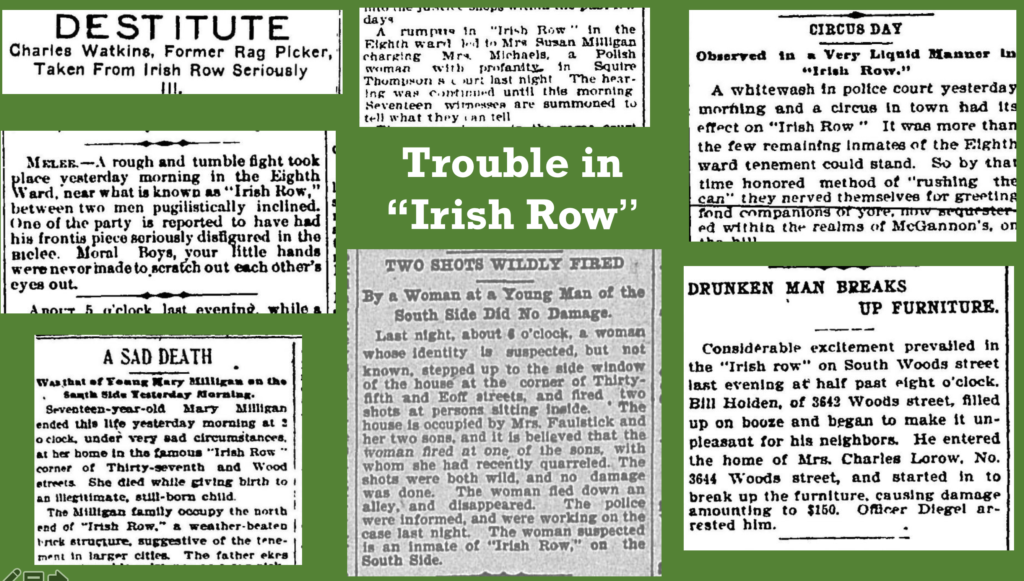
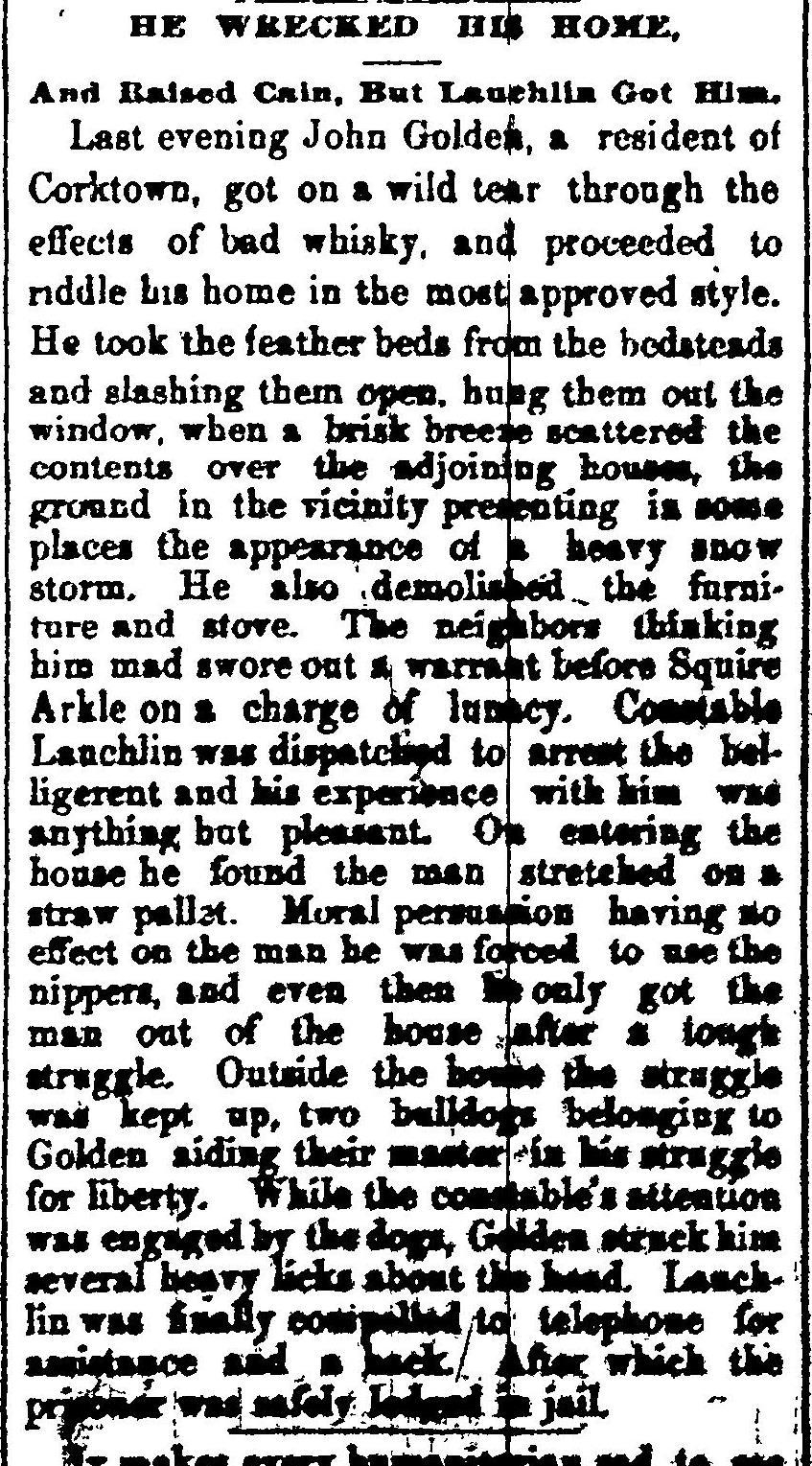 Another population of Irish people was concentrated in South Warwood and North Wheeling, in the area around the Top Mill (including company housing of Wheeling Steel & Iron), often referred to as "Corktown" or "Cork Town."
Another population of Irish people was concentrated in South Warwood and North Wheeling, in the area around the Top Mill (including company housing of Wheeling Steel & Iron), often referred to as "Corktown" or "Cork Town."
David O’Leary who immigrated to Wheeling from County Cork in 1874, was one of the founding members of “Corktown” as the area was once known. David’s grandson Bill was a founding member of the modern Division No. 1 A.O.H., as was Bill’s son Craig.
While never quite as sordid as Irish Row, Corktown had its share of bad reports, including a donnybrook in front of Costello's North Wheeling saloon (Intelligencer, 06-02-1881); or when Top Mill nail feeder Harry Paxton was shot in the belly for being too loud by one of the three Beal brothers who were held in jail nine months until Paxton finally died (Register, 09-01-1882); or when John Golden got drunk on "bad whiskey" and threw his featherbeds out the window creating an August snow storm ( see left image and Intelligencer, 08-11-1884); or when a man and woman were arrested for "being out for immoral purposes" (Register, 08-17-1887); or the time Mrs. Blake threatened to kill Lydia Nixon (Register, 08-28-1902).
Perhaps the same "Jack" Golden, a Top Mill boiler, is actually credited with naming that section of town "Corktown" to begin with (Register, 08-19-1875).
Like Irish Row (and most Wheeling towns), Corktown fielded a baseball team called the Sluggers that lost to the Loveland (South Warwood) club, 16-12 on the Bridge Works diamond in Glennova (North Warwood - Register, 05-08-1906).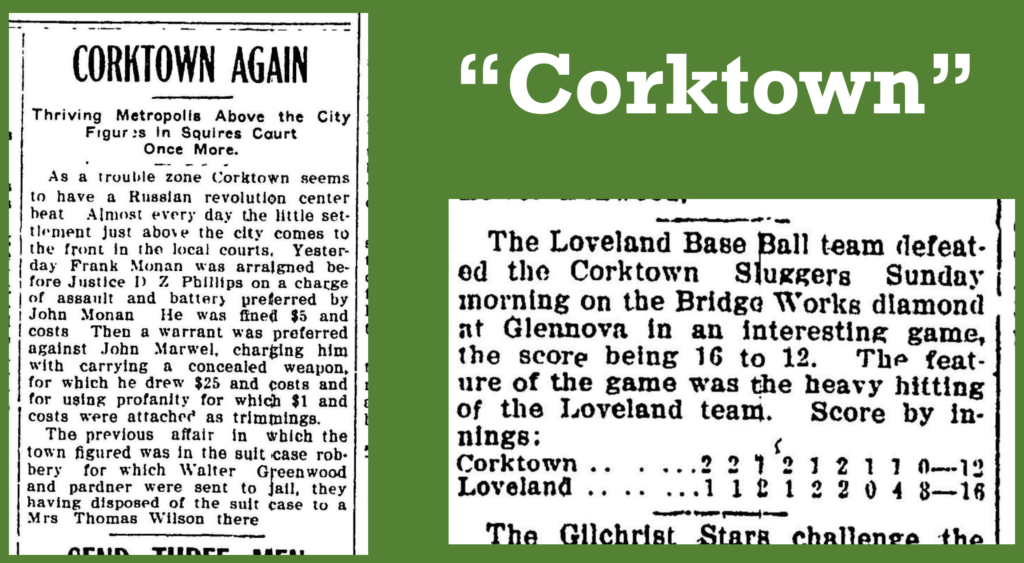
While primarily a German town in terms of immigration numbers, Wheeling was secondarily a very Irish town. This legacy is preserved through continuing traditions like the annual Celtic Celebration, Irish Road Bowling, and monuments like the Celtic Cross at Heritage Port.
We don't know if this particular parade on 16th Street in about 1916 was for St. Pat, but we do know Wheeling loved parades. - from the Real Photo Postcard Collection of the Ohio County Public Library Archives. Donated by Margaret Brennan.
More importantly, the legacy lives in us, the descendants of the people of Irish Row, Corktown, and Whelan's Irish Guard.
Historically, the Wheeling Irish have contributed mightily to local culture. We can thank our friend Margaret Brennan for the Celtic Cross at Heritage Port and celebrate our forebears like Sister Ignatius Farley, who saved many soldiers as a nurse during the Civil War, Michael Joseph Owens, the son of poor Irish immigrants whose inventions helped remove child labor from the glassmaking industry, and Thomas O’Brien, a civil servant who walked the Cumberland Road to get to Wheeling penniless, and whose descendants Tim and Mollie O’Brien now produce beautiful roots music.
The aforementioned County Roscommon immigrant John Charles Duffy, my own great-grandfather, who was a conductor on the B. & O. between Grafton and Wheeling, and his wife Julia Agnes Rooney Duffy, had a daughter Mary Duffy Garvey, who served as state president of the AOH ladies auxiliary for several years after 1912 and as state chairlady of Irish History. In the latter capacity, she campaigned for a national monument for the “Nuns of the Battlefield” to honor the various orders, including the Sisters of St. Joseph (Wheeling Hospital, like Sister Ignatius Farley), who nursed wounded soldiers during the Civil War. Finally dedicated in Washington D.C. in 1924, the monument is inscribed: “ERECTED BY THE LADIES AUXILIARY TO THE ANCIENT ORDER OF HIBERNIANS OF AMERICA. A.D. 1924.”
Remember also that your ancestors celebrated St. Patrick's Day with a vengeance. The March 18, 1874 Wheeling Daily Intelligencer recorded the first parade: Dillon J. McCormick of the A.O.H. led 400 marchers and three bands of music in “neat uniforms” starting at 2 o’clock from Institute Hall and proceeding: “up 14th street to Eoff, up Eoff to 11th, down 11th to Market, up Market to Washington (7th), down Washington to Main, up Main to [Wheeling] hospital, thence down Main to Twenty-Fourth, up Twenty-Fourth to Chapline, down Chapline to Thirty-third, down Thirty-third to Eoff, down Eoff to Thirty-sixth, up Thirty-sixth to Wood, up Wood to Thirty-third, down Thirty-third to Chapline, up Chapline to Twenty-third, down Twenty-third to Market, up Market to Seventeenth, up Seventeenth to Jacob, up Jacob to Fourteenth, down Fourteenth to Eoff, up Eoff to Twelfth, down Twelfth to Chapline, down Chapline to Institute Hall where the column broke ranks.” While Wheeling’s parade was not the oldest nor the best attended in the country, it may well have been the longest. The parade covered every corner of 1874 metropolitan Wheeling for an astounding total marching distance of six and a quarter miles!
Remember that dedication when you do your own -safe- celebrating this year.
And remember why our celebrations are so over the top.
Here in America, St Patrick’s Day is loud, green, drunken.
In Ireland it was a solemn religious holiday. Mass in the morning, quiet feast later. The pubs were even closed! Now they imitate us. Nativists mocked Irish in NY with “paddy-making” creating effigies of Irish wearing rags and potato necklaces and holding whiskey bottles. So these parades were an affront to the Know Nothings—they got bigger and louder. They are not really an Irish tradition at all—they are an American immigrant’s reaction. Here's how the great Larry Kirwan puts it:
"On one day a year, they congregated outside St. Patrick's Cathedral off Prince Street in New York City and marched in celebration. To some of these immigrant Irish and their American born children it [St. Pat's] was a religious occasion, but to most the gathering was an affirmation of their right, not only to survive but to thrive in their adopted country. That's what I sense on St. Patrick's Day - an echo from a time when the Irish were despised outsiders. And that's why I go along with the raucous energy, the excitement and even the green beer, the plastic shamrocks and the ubiquitous leprechaun." Read more.
And so, Wheeling, as you celebrate this St. Patrick's Day, please remember to make a hearty, robust, history-worth toast to the Wheeling Irish.
Slainte!
Margaret Brennan stands with the Celtic Cross she helped install in honor of the Wheeling Irish at Heritage Port.
Connelly, J. The Visit of Archbishop Gaetano Bedini to the United States of America (June 1853-February 1854). Rome.
1960. Duffy, S. "Whelan’s Irish Guard: The Ancient Order of Hibernians in Wheeling" 2012.
Duffy, S. The Wheeling Family: Immigrants & Their Neighborhoods. Creative Impressions. 2008.
St. John Parish, Benwood, West Virginia : 1875-1975. St. John Parrish. 1975. W
Wheeling Daily Intelligencer: 01-09-1854; 01-10-1854; 01-11-1854; 01-14-1854; 01-19-1854; 01-23-1854; 10-22-1878; 06-03-1897; 07-02-1897; 09-07-1897; 09-25-1897; 07-02-1898; 01-21-1902; 06-20-1902; 09-16-1903; 04-04-1905; W
Wheeling Daily Register: 03-10-1891; 10-02-1893; 05-13-1894; 06-03-1894; 07-14-1895; 09-25-1897; 01-31-1900; 02-03-1900; 08-14-1900; 10-11-1900; 07-07-1901; 08-22-1901; 12-05-1902; 01-16-1903; 08-31-1904; 11-15-1927; 03-17-1950; 03-21-1950; 03-29-1974
© Copyright 2025 Ohio County Public Library. All Rights Reserved. Website design by TSG. Powered by SmartSite.biz.